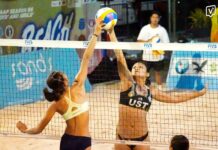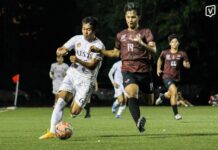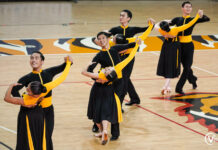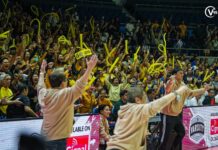EVERY year, universities recruit student-athletes to replenish their depleted lineups before the next UAAP season. One would think that UST, one of the top collegiate sports institutions in the country, does not have extreme concerns in this area.
But the truth is, the University loses most of its prized homegrown athletes each year yet some of the off-season recruits quit even before the UAAP season commences, while some veteran Tigers suddenly decide to transfer to other schools. Worse, some of them opt to enroll and play for other universities in the middle of the year.
Although it has been the undisputed UAAP overall champion for the past seven years, the University is having difficulty gathering its troops due to the growing concerns of student-athletes.
Recruitment diagram
To cope with the stiff competition of recruiting players, UST assures its junior varsity players a sure shot at the senior teams. They are not, however, guaranteed a Team A, or active roster, slot. Some are sent to Team B or C, the training pools.
Aside from junior athletes, the coaches scour the far-flung provinces for talented youngsters. Regional sporting events and the Palarong Pambansa usually abound with coaches on the hunt. This year’s Growling Tigres rookies John Lee Apil and and Angelo Canlas were drafted from Cagayan and Pampanga respectively.
Judo Coach Alberto Arce also established the Thomasian Goodwill Games in 2002, an inter-college tournament held every September to reduce costly provincial athlete scouting.
Being a top-rate recruit, however, does not guarantee high-class perks.
UST provides its athletes with the usual tuition discount and selective free board and lodging. But an athlete’s financial stability is also taken into consideration before he/she is given tuition discounts. The player who is capable of paying his or her dues to the University is exempted from the tuition and miscellaneous discounts.
Nevertheless, Team A players automatically get full scholarships and free miscellaneous fees. For members of Teams B and C, the benefits depend on the athlete’s skills, or if they are prized recruits, like those from other countries, who must first complete their two-year residency in the University before thay can be fielded in the UAAP wars.
Free board and lodging and food are provided to athletes from far provinces while players residing in Manila and nearby provinces such as Bulacan and Cavite stay in their homes.
Finally, players receive monthly allowance not exceeding 1,000 pesos, and are also given health benefits such as free treatment of injuries and hospitalization.
Cubs who choose not to be Tigers
Although the University offers immediate slots for juniors in the senior teams, it cannot keep its homegrown-talent roster intact.
“We cannot do anything if they prefer better offers from other universities. It is their right (to choose which school they want to play for),” athletics moderator Felix Michael Silbor told the Varsitarian.
Raymond Leyga, a former Tiger Cubs standout and Season 66 Mythical Five member, considers his decision to play for the University of the East (UE) as a career move.
The Growling Tigers’ then manager, Boy Ong, told Leyga he has to spend two years with Team B before he gets a crack at the regular lineup.
UE, meanwhile, offered Leyga an automatic slot in their Season 67 roster, an offer the young cager did not pass up.
However, Leyga tore an anterior cruciate ligament (ACL) in his right knee early into Season 67. The ACL injury prevents the player from making sudden movements that slows down the players’ mobility. After an insignificant first season as a Red Warrior, Leyga was sidelined from the roster to fully recover from his injury. He left the UE roster in April 2005, and plans to return to UST in 2007 should the University permit him to play.
Michelle Nize and Louise Sarmiento, big fishes of the UST Juniors Swimming Team, will not suit for the Tiger Sharks this UAAP Season 68 as they were drafted by DLSU and Ateneo respectively. Nize and Sarmiento were both UAAP Season 67 MVP awardees.
In Season 64, four-year UST veteran Joar Calvadores suddenly abandoned the Tiger Tracksters two months before the Athletics event.
University authorities found out that Calvadores enrolled in De La Salle University (DLSU) for the third semester.
Unsurprisingly, Calvadores, UST’s former skipper, helped DLSU bag two major events.
The only effort at preventing an athlete’s transfer is dialogues between the coaches and the athletes concerned.
“Pwedeng masunod yung mga advice namin, pwede ring hindi,” UST Girls Volleyball Coach Francis Vicente said.
As the UAAP Board does not have rules regarding athlete “piracy”, some universities offer student-athletes bigger benefits for their change of jersey.
De Sagon said the University has long been “victims” of this situation. There is little effort, however, to prevent it.
“We do not want to force our athletes to keep playing for us if they don’t want to,” De Sagon said.
Faithful recruits
While some UST athletes are discontented with the university’s sports program that makes them consider playing for other schools, there are players that deserve the credit for their loyalty. Former junior players Lorraine Zapanta (Volleyball), UAAP Season 67 Mythical Five member Mark Panahon (Basketball), Gio de Guzman, Jeffrey Salcedo, and Kelvin Tabago (Taekwondo) played for the UST Senior Team right after finishing high school.
“They are already in good hands, why would they go elsewhere?” Taekwondo Coach Dindo Simpao told the Varsitarian.
Other circumstances
On rare occasions, some UST coaches recommend that their athletes play for other universities, under trusted colleagues.
Award-winning Junior tracksters Tomas Limqueco and Rodolfo Angelico Caguioa played for the College of St. Benilde with their coaches’ recommendation.
“There were no available slots in the Seniors athletics team and the courses they wanted are not offered here,” Athletics coach Edna Carpio said.
IPEA Director Fr. Ermito de Sagon, O.P. said another factor is that National Team coaches offer slots in the Philippine team in exchange for an athlete’s services to other schools where the national coaches have connections.
“Mercenary” athletes or the graduate school athletes recruited by other universities to play in the UAAP, also greatly affect the Tigers’ campaign. Some universities scout for veterans from non-UAAP member schools.
De Sagon admitted to having several graduate school athletes in the UST rosters, but “they come from our own ranks.”
Come UAAP Season 69, mercenary athletes will be banned from playing in the UAAP.
Difficult affair
Truly, to recruit—to convince a young athlete to come study in and play for the school—is a difficult affair. Oftentimes the burden is on the coaches, who make most of the sales talk.
As to athletes who are already in the University, keeping them within the fold remains to be a problem.
“Mas ok sana kung dito sila, para makita mong lumaki ‘yung mga dumaan sa kamay mo.” Coach Francis Vicente told the Varsitarian.
As much as possible, Silbor said the University recruits the players that are needed in the teams.
But by and large, the decision remains with the athlete.
“It is their right to choose what is better for their careers,” Silbor said. Llanesca T. Panti

















